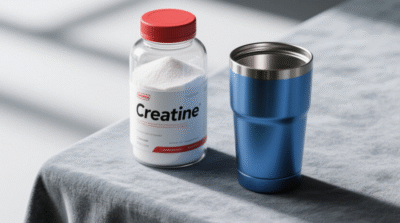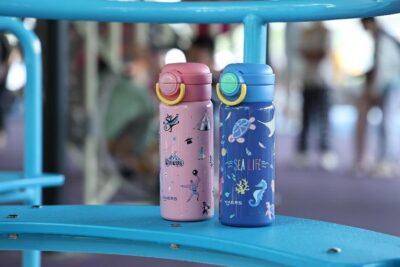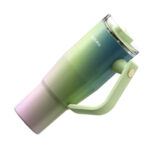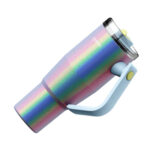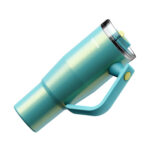Can Your Stainless Steel Cups Go in the Dishwasher?
More people are asking the same question: Can I safely put my stainless steel cups in the dishwasher as dishwashers become a staple in modern kitchens and offices?
It seems like a simple concern, but the answer isn’t always straightforward. Will the cup lose its shine? Will it warp or lose its vacuum insulation? Will the printed logo fade?
As a stainless steel cup manufacturer, we hear these questions all the time. That’s why we put our products through a series of professional dishwasher tests during production. In this article, we’ll walk you through what makes a cup truly “dishwasher safe,” what tests we perform in our facility, and how you can choose the right cups for long-term, hassle-free use.
Table of Contents
ToggleWhat Makes a Stainless Steel Cup Truly “Dishwasher Safe”?
Not all stainless steel cups are created equal — especially when it comes to dishwasher compatibility. To be considered dishwasher safe, a cup needs to withstand more than just a rinse. Here are the key requirements:
Heat Resistance: Dishwashers typically run at high temperatures, especially during the drying cycle. A dishwasher-safe cup must tolerate heat without warping, discoloring, or affecting vacuum insulation performance.
Structural Integrity: The cup’s body, base, handles (if any), and lid components must remain intact under strong water pressure. Weak welds or poorly assembled parts can loosen or break over time.
Chemical Resistance: Dishwasher detergents are often alkaline and abrasive. A dishwasher-safe cup should be able to handle repeated exposure without its surface coating, printed logo, or paint peeling off.
Material Safety: The internal surface must be made of food-grade stainless steel—ideally 304 or 316—to prevent any chemical leaching or metallic aftertaste when exposed to heat and detergent.
In short, a dishwasher-safe cup is one that looks, feels, and functions the same after dozens of wash cycles as it did when it was brand new. And as manufacturers, we make sure to put these standards to the test.
How We Test Our Stainless Steel Cups for Dishwasher Durability
When we say a stainless steel cup is “dishwasher safe,” we mean it has been through rigorous, standardized testing—not just a quick rinse-and-dry trial. In our water bottle manufacturing process, we follow globally recognized dishwasher testing protocols to ensure long-term durability, safety, and performance.
Testing Standards We Follow
Dishwasher testing standards are primarily defined by organizations like the International Organization for Standardization (ISO) and the European Committee for Standardization (CEN). Among them, ISO 8442-2 is one of the most widely adopted standards. It specifies detailed criteria for cleaning effectiveness, cycle time, water temperature, detergent concentration, and more.
Depending on regional requirements or client brand standards, we also reference:
- EN 50242 (Europe)
- ANSI/AHAM DW-1 (United States)
While different regions may have slight variations, global dishwasher standards have largely aligned over time. As of early 2023, the industry standard for testing painted or powder-coated stainless steel cups with printed designs is as follows:
The product must undergo at least 20 consecutive dishwasher cleaning cycles, using a standard wash program. After cleaning, the cup’s surface should show no paint peeling, no fading or loss of printed patterns, and no corrosion or discoloration on the inner wall.
The overall structure should remain unchanged—no warping, shrinking, or deformation. Once air-dried, the cup must pass a secondary insulation test to confirm no loss of thermal performance caused by the dishwasher process.
Test Focus by Material Type
While we specialize in stainless steel, we also work with other materials, and each has its own testing focus:
- Stainless Steel Cups: We prioritize coating durability, ensuring inner linings don’t peel, and that no strange odors or harmful substances are released even after repeated cleaning. The metal must maintain both its integrity and clean taste profile.
- Tritan Plastic Cups: Must withstand repeated high-temperature cycles without softening, warping, or chemical leaching. Transparent plastics should remain clear (not cloudy), while matte or frosted finishes must resist abrasion and peeling.
- Glass Cups: Tested for thermal shock resistance, they must survive rapid temperature changes without cracking. Cup rims and bottoms are checked for post-wash durability, and colored coatings must not fade or flake. Safety is ensured by testing for no leaching of heavy metals.
By tailoring our tests based on material, we make sure every product—regardless of design or finish, can safely withstand real-world dishwasher use.
Which Types of Stainless Steel Cups Are Best for Dishwasher Use?
Not all stainless steel drinkware performs equally well in a dishwasher. Some are built to handle repeated high-heat washing cycles, while others may degrade over time if not properly designed. Based on our testing and manufacturing experience, here’s what to look for when choosing dishwasher-friendly stainless steel cups:
1. Single-Wall Stainless Steel Cups
Single-wall cups without insulation or vacuum layers are generally the most dishwasher-compatible. With fewer components and no risk of vacuum seal damage, these cups can endure high heat and water pressure without issue.
2. Vacuum Insulated Cups with Removable, Washable Lids
Double-walled or vacuum-insulated stainless steel cups can be dishwasher safe—as long as:
- The lids are made from high-quality, heat-resistant plastic or silicone.
- All components are detachable for thorough cleaning.
- The vacuum seal is not compromised by repeated hot water exposure.
In our factory, we ensure our insulated cups pass both dishwasher and thermal retention tests after cleaning, so functionality isn’t lost.
3. Laser-Etched or Engraved Designs
Cups with laser-etched logos or markings are far more durable in a dishwasher than those with screen-printed or sticker-applied graphics. Laser etching fuses directly with the steel surface, so there’s no risk of fading or peeling.
4. High-Grade Materials (304 or 316 Stainless Steel)
Always check the material. Food-grade 304 (18/8) or 316 stainless steel is corrosion-resistant, non-reactive, and stable under high heat and detergent exposure. These grades don’t rust or leach metals, and they preserve the taste of your beverages.
5. BPA-Free, Dishwasher-Safe Lids and Seals
Even if the cup itself is dishwasher safe, the lid matters just as much. Look for BPA-free lids made from Tritan, PP, or silicone that won’t degrade or release harmful substances during high-heat washing. Removable gaskets are also a plus—they prevent mold buildup and are easier to keep clean.
By understanding the construction, materials, and surface treatment of a stainless steel cup, you can easily determine if it’s fit for the dishwasher—or if it’s better off hand-washed.
5. Even Dishwasher-Safe Cups Need Smart Care
Just because your cup is labeled “dishwasher safe” doesn’t mean you can completely skip basic care. To ensure your stainless steel drinkware stays in top condition and performs well over time, a little extra attention goes a long way. For example, while most high-quality lids can handle dishwasher cycles, repeated exposure to heat and detergent may cause silicone gaskets or seals to wear out faster than expected. Hand washing these parts when possible helps maintain their tight fit and prevents leaks down the road.
It’s also wise to avoid using high-heat drying settings in your dishwasher. Modes like “heated dry” or “sanitize” expose your cups to prolonged high temperatures, which might gradually affect the vacuum insulation layer or cause surface coatings and colors to fade more quickly. When loading your dishwasher, placing your cups on the top rack is a good practice, as this area usually experiences gentler water pressure and lower heat, reducing the risk of damage—especially for insulated cups or those with printed designs.
Another factor to consider is preventing surface scratches. Avoid placing cups next to sharp utensils or heavy cookware during the wash cycle, as constant friction may dull finishes or cause micro-scratches, particularly on matte or painted surfaces. Lastly, after the washing cycle is complete, it’s best to let your cup air dry thoroughly before putting the lid back on. This is especially important for vacuum-insulated cups, as sealing in moisture can lead to unpleasant odors or mold buildup over time.
Taking these simple but smart steps helps preserve both the function and appearance of your cup, ensuring that even a dishwasher-safe product stays in great shape for years to come.
At our factory, we welcome custom projects with dishwasher compatibility as a priority. From selecting premium 304 or 316 stainless steel to ensuring durable coatings and reliable seals, we strive to deliver cups that meet your highest expectations for durability, safety, and usability.
If you’re interested in stainless steel cups that combine style, function, and dishwasher durability, feel free to reach out. We’re here to help you find the perfect solution for your needs.


